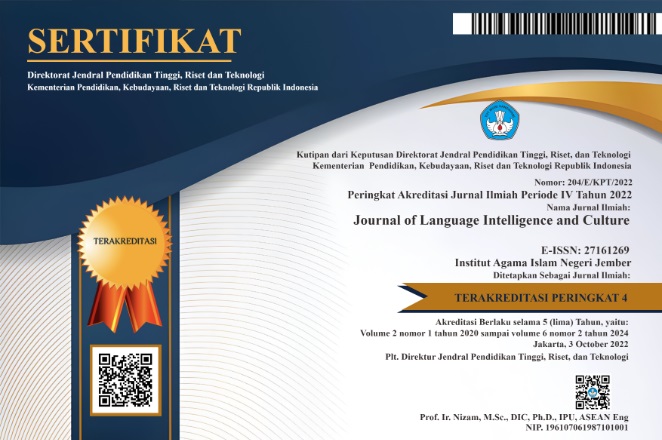Digital Writing Assistance in EFL Contexts: A Study on Grammarly Use by Indonesian Students
DOI:
https://doi.org/10.35719/jlic.v7i1.639Keywords:
Digital writing, Grammarly, EFL studentsAbstract
This study investigates the efficacy of Grammarly, an automated writing assistance tool, in enhancing the writing proficiency of EFL students at UINSI Samarinda. Fifty third-semester students participated and were divided into two groups: an experimental group receiving instruction supplemented by Grammarly and a control group following conventional writing instruction without technological support. The analysis employed a quasi-experimental design comparing growth scores, defined as the difference between pre-test and post-test scores for each student. Both groups showed normal distribution (Shapiro-Wilk, p > 0.05) and homogeneity of variances for pre- and post-test scores (Levene’s test, p > 0.05), except for the improvement scores, which violated homogeneity (p = 0.000). The Grammarly-assisted group improved significantly more (pre-test M = 59.48, post-test M = 84.16) than the control group (pre-test M = 56.28, post-test M = 65.28), with a mean improvement difference of 15.68 points (t = -9.847, p = 0.000). The effect size was small to moderate (Cohen’s d ≈ 0.34). These findings suggest that Grammarly provides effective support in developing EFL writing skills and underscore the need for further research on student perceptions of digital writing tools in language education.
References
Alharbi, W. (2023). Ai in the foreign language classroom: a pedagogical overview of automated writing assistance tools. Education Research International, 2023, 1-15. https://doi.org/10.1155/2023/4253331
Alshehri, M. (2024). Integrating automated writinng evaluation into efl writing practice.. https://doi.org/10.21203/rs.3.rs-4793625/v1.
Arisandi, V. and Sudarajat, A. (2023). Revisiting “grammarly” in hiigher education (a literature review). Journal of Innovation Research and Knowledge, 2(8), 3351-3356. https://doi.org/10.53625/jirk.v2i8.5461.
Binangbang, J. (2020). The effect of substitution, augmentation, modiification and redefinition model on students’ writing skills. Middle Eastern Journal of Research in Education and Social Sciences, 1(2), 29-51. https://doi.org/10.47631/mejress.v1i2.131.
Coloquit, L. M. P., Canabal, L. A., & Paderan, M. P. C. (2020). Improving students’ english writing proficiency through interactiive writing technique. Journal of English Education and Linguistics, 1(1), 72-81. https://doi.org/10.56874/jeel.v1i1.50.
Dergaa, I., Chamari, K., Żmijewski, P., & Saad, H. B. (2023). From human writing to artificial intelligence generated text: examining the prospects and potential threats of chatgpt in academic writing. Biology of Sport, 40(2), 615-622. https://doi.org/10.5114/biolsport.2023.125623
Dewi, U. (2023). Grammarly as automated writing evaluation: its effectiiveness from efl students’ perceptions. Lingua Cultura, 16(2), 155-161. https://doi.org/10.21512/lc.v16i2.8315.
Fitria, T. N. (2022). Identifying grammatical and mechaniical errors of students’ writing: using “grammarly” as an online assessment. Lingua Didaktika: Jurnal Bahasa Dan Pembelajaran Bahasa, 16(2), 169. https://doi.org/10.24036/ld.v16i2.116824.
Fitriana, K. and Nurazni, L. (2022). Exploring students' perceptiion of using grammarly to check grammar in their writing. JET (Journal of English Teaching), 8(1), 15-25. https://doi.org/10.33541/jet.v8i1.3044
Ginting, R. S. B. and Fithriani, R. (2022). Peer and automated writing evaluation (awe): indonesian efl college students’ preference for essay evaluation. LLT Journal: A Journal on Language and Language Teaching, 25(2), 461-473. https://doi.org/10.24071/llt.v25i2.4879
Halaweh, M. (2023). Chatgpt in education: strategies for ressponsible implementation. Contemporary Educational Technology, 15(2), ep421. https://doi.org/10.30935/cedtech/13036.
Inayah, T. M. and Apoko, T. W. (2024). Exploriing students' perspectives on the use of grammarly in writing analytical exposition text. JLE: Journal of Literate of English Education Study Program, 5(1), 73-83. https://doi.org/10.47435/jle.v5i1.2802
Karagül, B. İ. and Şeker, M. (2021). Improving language learners’ use of self-regulated writing strategies through screencast feedback. Sage Open, 11(4). https://doi.org/10.1177/21582440211064895
Khan, M. O., Nazim, M., & Alzubi, A. A. F. (2024). Exploring arab efl lerners' attitudes: is grammarly a game-changer in academic writing classes?. Educational Administration: Theory and Practice. https://doi.org/10.53555/kuey.v30i4.1612.
Khojasteh, L., Hosseini, S. A., & Nasiri, E. (2021). The impact of mediatd learning on the academic writing performance of medical students in flipped and traditional classrooms: scaffolding techniques. Research and Practice in Technology Enhanced Learning, 16(1). https://doi.org/10.1186/s41039-021-00165-9
Miranty, D., Widiati, U., Cahyono, B. Y., & Suzila, T. I. (2023). Automated writing evaluation tools for indonesian undergraduate english as a foreign language students’ writing. International Journal of Evaluation and Research in Education (IJERE), 12(3), 1705. https://doi.org/10.11591/ijere.v12i3.24958
Prasetya, R. E. and Raharjo, D. H. (2023). Enhancing english language writing skills: an evaluation of the efficcy of grammarly application. Journal of English Language Studies, 8(2), 320. https://doi.org/10.30870/jels.v8i2.19294
Puri, G. and Setiamunadi, A. A. (2023). The use of grammarly by tertiary english language learners in their onlin writing classes. English Education:Journal of English Teaching and Research, 8(2), 163-179. https://doi.org/10.29407/jetar.v8i2.20981
Resiana, A. T., Zamzam, A., Putera, L. J., Amrullah, A., & Arrfah, H. (2024). Effectivness of grammarly application on the students' argumentative writing progress. Journal of English Education Forum (JEEF), 4(3), 153-159. https://doi.org/10.29303/jeef.v4i3.722.
Roy, K. and Swargiary, K. (2024). Chatgpt impact on efl indian undergraduatea. https://doi.org/10.20944/preprints202405.0130.v2.
Setyani, E. D., Bunau, E., & Rezeki, Y. S. (2023). The influence of grammarly towards indonesian efl students’ first-degree thesis writing confidence. Elsya : Journal of English Language Studies, 5(1), 54-67. https://doi.org/10.31849/elsya.v5i1.6773.
Song, C. and Song, Y. (2023). Enhancing academic writing skiills and motivation: assessing the efficacy of chatgpt in ai-assisted language learning for efl students. Frontiers in Psychology, 14. https://doi.org/10.3389/fpsyg.2023.1260843.
Ummah, L. K. and Bisriyah, M. (2022). Efl students’ perception of grammarly’s feedbck and how they deal with the inaccuracy. JEES (Journal of English Educators Society), 7(2). https://doi.org/10.21070/jees.v7i2.1687.
Wu, Y. and Schunn, C. D. (2020). The effects of providing and reciving peer feedback on writing performance and learning of secondary school students. American Educational Research Journal, 58(3), 492-526. https://doi.org/10.3102/0002831220945266
Downloads
Published
How to Cite
Issue
Section
License
Copyright (c) 2025 Tia Rahmatika

This work is licensed under a Creative Commons Attribution-ShareAlike 4.0 International License.













